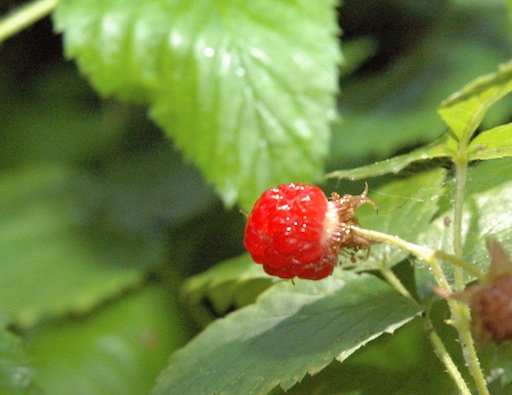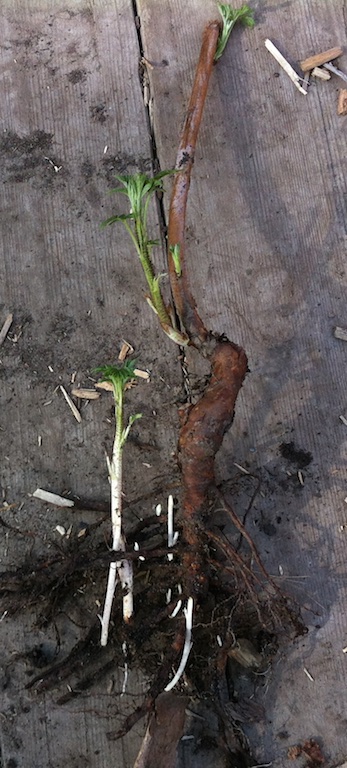
Inventory tables are double rows to make them usable on small screens.
Common name and container in column 1.
Count is how many we think we have left. Price is per tree.
Height will be there next year, we hope.
Food -- Raspberry
| Common Name Container |
Count Price |
Height (feet) |
|
| Raspberry, Assorted #2 Std pot (6 qt) |
24 $25.00 |
||
| Raspberry, Double Delight Bare Root Seedling |
-7 $2.25 |
||
| Raspberry, Festival Bare Root Seedling |
-25 $2.25 |
||
| Raspberry, Festival 1-2 yr Bare Root Seedling 25/bundle |
-25 $2.25 |
||
| Raspberry, Festival Bare Root Seedling |
97 $2.25 |
||
| Raspberry, Festival #N/A |
-25 $2.25 |
||
| Raspberry, Red Bounty Bare Root Seedling |
15 $2.25 |
||
| Raspberry, Souris Bare Root Seedling |
-27 $2.25 |
||
| Last Update: 2024-Jan-21 | |||

Raspberries grow wild, some native, some feral, some hybrids. Wild ones tend to grow in partial or deep shade. The reduced sunlight makes for fewer and smaller berries.

With domestic berries in the sun, you tend to get this: clusters of berries. Not all ripen at the same time.

This is a very fancy trellis, but it illustrates the principles of keeping your berries upright. I prefer to use heavy twine or light rope, as you can take them down to clear out old canes, and to transplant new canes that are coming up in the wrong place.

This is how canes come in. Ok. It's about two weeks after it came in. This one needs to get into the ground ASAP. Note the new canes starting from the root.
This is a prime example of a souris cane. it was unloved and unsold as a bare root 2 yr old, so ended up in a pot, to sell later at 4 times the price. Souris canes are larger since they have a 2 year long cycle.

Q. What can be better than a sun warmed raspberry fresh off the bush?

A. Lots of sun warmed raspberries!

When I have leftover stock, it gets potted up. Some sells. Some provides motivation for the weeders.
Raspberries
Rubus idaeus
Raspberries are one of the easiest plants to grow. Stuff them in the ground, keep them moist, and you will have raspberries almost forever.
Raspberries come in two types: Primocane and Floricane
Floricanes are the most common, and the only ones with significant commercial use. They bear heavily for a few week in early summer. The bear only on side branches of the 2nd year canes.
Primocanes produce less fruit per bush, and spread that production out over a longer period of time, starting a few weeks after the floricanes finish, and continuing to frost. They are also shorter, and can be packed closer together. Because they run through the whole cycle in a single year, they benefit from a warm micro climate. You will get earlier fruit against a south facing wall or fence, and they will still produce until fall.
Alas, it's not quite this simple. Some floricanes will produce fall berries on first year canes. Some Primocanes will have a light crop on canes their second summer. And some of the little raspberries that come up are hybrids between the two, or between them and wild ones.
I've chosen to carry two types of raspberries.
Souris raspberry is a floricane similar in berry size to Boyne. Souris has better yields, and is more cold resistant.
2020 Souris is out of stock. This year new bare root stock is Boyne. Very similar, but older cultivar. I still have 1 gallon stock of Souris from last year.
Double Delight raspberry is a primocane, producing slightly smaller berries. Berries start in mid to late August, a few weeks after Souris, and keep bearing lightly all the way to frost.
Red River This is the earliest primocane. Larger berries than Double Delight. I'm considering Red River for 2021. Let me know.
I sell them in 25's because that's about right for a single family. 25 Souris and 50 Double Delight will give you fairly regular raspberries on the cornflakes during the bearing season with a few occasions of raspberries on ice cream sprinkled in.
Excess fruit can be frozen loose on cookie sheets, and dumped into a bag. Take them out as desired for muffins, or desert. They will be very soft, almost jam when they thaw.
Planting and care
Raspberries like a moist loamy soil. They are fairly shallow rooted. 4-5 inches of decent soil is lots. If you have heavy clay or sandy soil, mix in large quantities of organic material. Peatmoss, dried leaves, compost, wood chips, bark chips. Avoid large quantities of fine sawdust and fresh pine or spruce bark until it's been composted -- it sucks the nitrogen from the soil, and spruce wood has natural chemicals that are tough on other plants. Rototil in, water thoroughly.
Plant in a single row, 6 inches to a foot a apart. Try to match the root collar on the canes with the new dirt in their bed. You don't have to be fussy about it, a centimeter either way won't matter.
Mulch heavily with wood chips or bark, or grass clippings, or straw during the summer. Helps with weed control and reduces watering. Water when the bottom side of the mulch is dry.
Lay down used carpet fuzzy side down on either side, and snug up a few inches away from the row. Take up in the fall, and store dry. Reapply in spring once you have moved any strays, and the weeds are coming back. This acts as weed control, moisture control, and keeps the berries that fall off clean enough to pick up and eat anyway. (Yes! Another sun-warmed raspberry!)
Support
Put a permanent stake in every 8-12 feet. This can be an old fence post, or a cedar post. I am concerned about leaching of new pressure treated wood near stuff I eat, but a 20 year old post has lost most of what will leach.
Attach two 12-16 inch cross bars to each post, like old style telephone poles, and put a small fence staple (used for chicken wire) in each end. The cross bars should be at about 18 inches and 3 feet above the ground.
Run a chunk of twine along the tips of the cross bars. These keep the canes from flopping into the aisles. The twine is sacrificial. Remove in spring when cleaning up the dead canes, and replace.
Yearly cycle
In spring take down the trellis strings, and remove dead canes. For primocanes you can just mow them, if the number of live canes in spring is small. For floricanes, you just have to pick them out by hand, or grow twice as many, and mow one row each year. The dead canes are pretty obvious, and snap at a touch. This can be done the first nice day that the snow is gone.
For floricanes, put the trellis strings back up, or use new ones. (plastic baling twine is cheap. Ask at your farm store.) Primacanes may want to wait until after your first weeding to put back the strings.
With spring you will see new canes come up, usually a few inches away from the old ones. If they come up too far from the row, you can transplant them when they are about 3-6 inches tall. Either transplant back into the row, where you have a space, or start a new row with them, or pot them up for friends. This is one reason why you remove the carpet in the fall.
Once the stinkweed starts to come up, lay out the aisle carpets.
Remulch as needed. Fertilizer advice depends: Google is your friend. I don't know yet.
Berries are ripe when they pull off easily from the core.
Winter Injury Prevention
The following precautions may prevent winter injury:
- do not trim the new canes back after July 1
- do not over-fertilize with nitrogen
- choose a site well sheltered from prevailing winds
- reduce soil moisture by withholding water from the middle of August until late fall
- water-in well in late fall, after leaf drop
In fall after the poplar leaves drop, turn your carpets over to dry, then when dry, roll up and store for winter. This will double or triple the life of the carpet.
I recommend that you use only non-glue down carpet. I've no idea what that glue + sunlight turns into. The rest of carpet is usually a jute fiber back, and a mix of nylon and polyester, and PET. (pop bottle plastic) All are fairly harmless.
Inventory tables are double rows to make them usable on small screens.
Common name and container in column 1.
Count is how many we think we have left. Price is per tree.
Height will be there next year, we hope.
Food -- Raspberry
| Common Name Container |
Count Price |
Height (feet) |
|
| Raspberry, Assorted #2 Std pot (6 qt) |
24 $25.00 |
||
| Raspberry, Double Delight Bare Root Seedling |
-7 $2.25 |
||
| Raspberry, Festival Bare Root Seedling |
-25 $2.25 |
||
| Raspberry, Festival 1-2 yr Bare Root Seedling 25/bundle |
-25 $2.25 |
||
| Raspberry, Festival Bare Root Seedling |
97 $2.25 |
||
| Raspberry, Festival #N/A |
-25 $2.25 |
||
| Raspberry, Red Bounty Bare Root Seedling |
15 $2.25 |
||
| Raspberry, Souris Bare Root Seedling |
-27 $2.25 |
||
| Last Update: 2024-Jan-21 | |||
Got something to say? Email me: sfinfo@sherwoods-forests.com
Interesting? Share this page.
Want to talk right now? Call me: (8 am to 8 pm only, please) 1-780-848-2548
Do not arrive unannounced. Phone for an appointment. Why? See Contact & Hours That same page gives our hours of operation.
Back to Top
Copyright © 2008 - 2021 S. G. Botsford
Sherwood's Forests is located about 75 km southwest of Edmonton, Alberta. Please refer to the map on our Contact page for directions.
